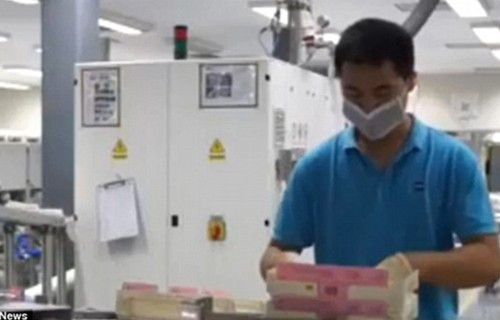导读:近年来,中国接受了越来越多的海外订单,对劳动力的需求大大上升。但是,这也使得劳动力价格不断攀升。为了保证生产利润,很多中国工厂开始用机器人代替高薪劳动力。

More and more factories in China are using robots on the assembly lines to replace workers who demand high salaries.
越来越多的中国工厂在组装线上使用机器人,以取代高薪劳动力。
Factories have struggled to keep up with overseas orders due to the rising labour cost and instead opted for machines, according to a report by China Central Television Station(CCTV).
CCTV报道称,由于上升的劳动力成本,工厂已经奋力选择机器生产以追赶海外订单的需求。
One boss, from Guangdong Province, said his factory started using robots after they realised the labour cost in China was twice as much as that of Mexico and four times as that of India.
来自广东省的一名老板称,自从他们意识到中国劳动力成本是墨尔本的两倍,印度的四倍以后,他们开始使用机器人。
A reporter from CCTV visited two robot-equipped factories, both situated in Guangdong Province.
中央电视台的记者造访了两家配置机器人的工厂,他们都位于广东省。
The region, located in southern China, is well-known for its large number of factorieshandling overseas orders for famous brands including Disney.
该地区位于中国南部,因为拥有大量承接海外著名商标(包括迪斯尼)订单的工厂而闻名。
One factory, which produces lenses for German brand Carl Zeiss in Guangzhou, started using robots four years ago in a bid to improve productivity and to cut costs.
为德国品牌卡尔·蔡司生产镜头的一家广东工厂,在四年前开始使用机器人,为了提高生产率,降低成本。
Its manager Zeng Zhiyong told the reporter that they were informed in 2012 that China’s labour cost is twice more expensive than Mexico’s and four times more expensive than India’s.
它的经理曾志勇告诉记者,他们在2012年的时候,获知中国劳动力成本比墨尔本高两倍,比印度高四倍。
Zeng told CCTV:
曾告诉中央电视台:
’We were very surprised at this huge gap and started to think of how to improve productivity.’
“我们对这个巨大差异感到震惊,开始思考如何提高生产率。”
Between 2012 and 2015, Zeng cut down the number of workers by 70 people - from 440 to370- but managed to increased the output from four million to five million lenses per year.
2012年到2015年间,曾削减了70名员工,员工总数从440名降至370名,但是同时试图将镜头年产量从400万增加到500万。
Rongxin Packaging Corporation produces 1.8 million cans per day.
荣兴包装公司每天生产180万个罐头。
Impressively, the entire production process does not involve any workers, its generalmanager Ji Yonghong told CCTV.
出乎意料地是,整个生产过程没有工人参与,该厂的常务经理季永红告诉中央电视台。
However, Ji said the factory has employed younger, more skilled and better-educated workers to maintain the machines and control the quality.
然而,季说,工厂雇佣更年轻,技艺更高,受教育程度更好的工人来运转机器,控制生产质量。
China became the world’s largest market for industrial robots in 2013. According to People’s Daily Online, more than 20 per cent of the world’s industrial robots are purchased by China.
2013年,中国成为世界最大的工业机器人市场。据人民日报英文在线报道,中国购置了超过20%的世界工业机器人。
Last year, the Chinese authorities named automated machine, tools and robotics as one of the 10 priority sectors in the ’Made in China 2025’ plan, a 10-year plan unveiled by China’s State Council in a bid to transform China ’from a manufacturing giant into a world manufacturing power’.
去年,中国当局将自动机器、工具和机器人提名为“中国制造2025计划”十大优先领域,这是中国国务院发布的一个十年计划,旨在将中国从一个制造业巨头转型为世界制造业强国。
This has prompted many factories in China to start replacing the workforce with modern machines.
这促进了很多中国工厂开始用现代机器取代劳动力。
Foxconn, the Taiwanese company which assembles iPhones and iPads, has also brought in machines to replace its 60,000 workers in one of its branches in southern China.
Foxconn是一家组装 iPhones 和 iPads的台湾公司,他们同样引入机器,取代位于中国南部一家分公司的六万名员工。
The robots took over repetitive tasks and took the place of more than half of the factory’s 110,000-strong workforce.
机器人接管了重复性任务,取代了工厂一半的壮劳动力。
While a growing number of Chinese factories are upgrading its production with hightechnology, the working conditions of some of them remain worrying.
伴随着越来越多的中国工厂正在使用高科技升级生产力,他们其中一些的生产条件仍然堪忧。
Previous Mailonline investigations discovered that impoverished men and women from rural areas work 12-hour shifts for pound 250 a month in Pegatron, a factory in suburbanShanghai which produces Apple products.
先前的线上邮件调查发现,来自农村地区的穷困男女劳动力,在上海郊区一家生产苹果产品的工厂每天劳作12个小时,每月工资250英镑。
While in southern China’s Dongguan city, migrant workers toil 11 hours a day and six days a week making Frozen toys for Disney at a factory.
与此同时,中国南部城市东莞的外来务工人员每天工作11个小时,每周工作六天,为迪士尼制作玩具。







